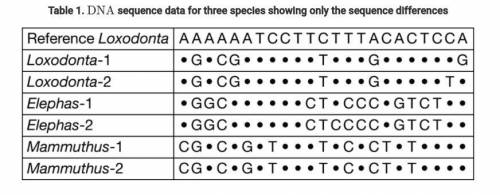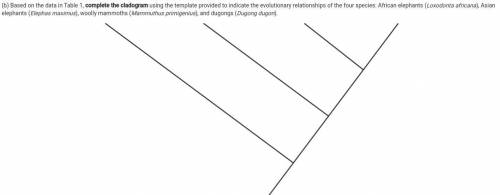
Biology, 12.05.2021 04:00 pishoy9357
HELP
Read each question carefully. Write your response in the space provided for each part of each question. Answers must be written out in paragraph form. Outlines, bulleted lists, or diagrams alone are not acceptable and will not be scored.
Researchers studying the phylogenetic relationships among African elephants (Loxodonta africana), Asian elephants (Elephas maximus), and woolly mammoths (Mammuthus primigenius) analyzed cytochrome b DNA sequences from several organisms of each species. Cytochrome b is a mitochondrial protein that functions in the electron transport chain. Partial sequences of cytochrome b mitochondrial DNA are often used in phylogenetic analyses. DNA was obtained from mammoth bone fragments radiocarbon dated to between 12,000 and 14,000 years ago and from living African and Asian elephants. Table 1 shows a partial cytochrome b DNA sequence for the reference individual (an African elephant) and some of the sample individuals studied. Dugongs (Dugong dugon) were identified as the outgroup in this study. Dugongs are marine mammals that are relatives of the larger group of elephant-like animals, the proboscideans.
(a) Based on the data in Table 1, identify the animal that has the greatest number of sequence differences from the reference animal.
(b) Based on the data in Table 1, complete the cladogram using the template provided to indicate the evolutionary relationships of the four species: African elephants (Loxodonta africana), Asian elephants (Elephas maximus), woolly mammoths (Mammuthus primigenius), and dugongs (Dugong dugon).
(c) Based on morphological and molecular data, researchers hypothesize that the split between dugongs and proboscideans likely occurred between 48 and 34 million years ago. Explain how molecular data from fossils and living organisms would support the existence of an evolutionary relationship between dugongs and proboscideans.
(d) There are six living species of mammals called hyraxes in the order Hyracoidea. These are small rabbit-like mammals that are also considered to be close relatives of both dugongs and elephants. All of these mammals are widely different morphologically. Explain how organisms that are widely different in morphology can have a close evolutionary relationship.



Answers: 2
Another question on Biology

Biology, 21.06.2019 22:00
Nasa scientists must work together to make sure that everything is correct and accounted for when launching a shuttle. besides a physicist, what other type of scientist would be in making sure that the shuttle has the appropriate type and amount of fuel to reach its destination?
Answers: 2

Biology, 21.06.2019 23:40
When coal has reached it hardest, darkest form, it is called select one: 0 a. sub-bituminous b. lignite c. bituminous d. antrhacite next page
Answers: 3

Biology, 22.06.2019 02:30
Apaleontologist finds a plant fossil that shows that the plant had seeds. what can the paleontologist conclude?
Answers: 1

Biology, 22.06.2019 06:50
The kidney filters potentially toxic substances in the blood, and thus “clears” the blood of those substances. this clearance function is dependent upon and proportional to the diffusion gradient of the substance across filtering capillaries, i.e. if the concentration of the substance is doubled, twice as much will be cleared from each ml of blood that is filtered. suppose that the body produces a constant amount of a substance x per unit of time. the kidneys eliminate substance x at a rate directly proportional to the concentration of the substance and the volume of blood cleared each minute (c): elimination = c × [x], where [x] is the steady-state concentration of substance x. imagine an individual with an initial concentration of x equal to [x]0 who develops kidney disease. her baseline clearance c0 drops to one half of the original (½c0). what is the new steady state concentration of x? (for simplicity, assume that substance x is 100% filtered by the kidney).
Answers: 1
You know the right answer?
HELP
Read each question carefully. Write your response in the space provided for each part of each...
Questions


Computers and Technology, 14.02.2020 16:33



Social Studies, 14.02.2020 16:34

Computers and Technology, 14.02.2020 16:34





Computers and Technology, 14.02.2020 16:34

Mathematics, 14.02.2020 16:34











